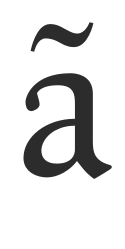

Windows instructions from the post above: To get these characters, press OPTION (ALT), and while holding down the OPTION key, type the e key. “If you are typing Gaelic in Nova Scotia, or quoting an older Scottish text, you may need the acute-accented characters á, é, or ó. For é, hold down the e Same thing for á and for ó…” “…if you’re typing in Nova Scotia Gaelic… you can also type some of the acute characters. IPhone/Android instructions from the instructional video: Keeping your finger in contact with the screen, slide up and over to highlight the à and then take your finger off the screen. “Touch the key of the accented letter that you want to type, for example, a, and hold your finger on the key until you see a pop-up window displaying a range of accented letters. IPhone/Android instructions from the text of the post above are generalized: Not sure where you get the idea that I’m ignoring our Nova Scotia Gaelic accented letters in this post. Speaking of smartphones, have you considered doing a post on Gaelic text abbreviations? There are quite a few abbreviations used by Irish texters, including two of my favorites, “an8” (anocht) and “a#” (a thaisce). It doesn’t work in all circumstances - you still have to watch what you’re typing - but in general it works very well (I do get a bit of a kick out of it when it puts accents on English words because I’m too lazy to toggle back to the standard iPhone keyboard, however. One thing I love about the swiftkey app on my phone is it automatically intuits the need for a fada (acute accent mark), which is a little bit faster than having to do the “hold down-slide-tap” method. It’s nice to have so many choices, as what works well for one may be less comfortable for others. I also have to use alt codes a lot at work, so they come pretty naturally to me. Because of that, I started using alt codes, and for me, now, they’re the simplest method because I can touch type them without thinking about it. When I first started learning Irish, I worked on a shared computer, and it was frustrating to the others when they’d forget to switch back to the standard American keyboard (certain characters shift around on the international keyboard, including the rather important symbol). To some extent it depends on what you’re used to. Now immediately type the letter you want.

Press OPTION (ALT), and while holding down the OPTION key, type the ` key (it’s the key with both a grave accent ` and a tilde ~ on it, usually to the left of the numeral 1 key).

:max_bytes(150000):strip_icc()/wood-block-letters-spelling--fran-ais---white-background-928023852-9a8dc29ccfc3409c9a8a24737d15a8c0.jpg)
On a Mac, to type the lowercase accented letters à, è, ì, ò, and ù: To get the accented capital letters, press the SHIFT key on your phone’s keyboard and then repeat the above process. Touch the key of the accented letter that you want to type, for example, a, and hold your finger on the key until you see a pop-up window displaying a range of accented letters. In the video I’m using the Notes app as an example, but it works in email, texting, Facebook, Twitter, and everywhere else. Open up any app in which you want to type.
How to make tilde and accent on ipad how to#
If you want to type in Scottish Gaelic on your iPhone or Android smartphone, here’s how to type the accented characters. I’ve made a screenshot video of this process. Typing accented letters on iPhone or Android Nisd, move the cat off your keyboard and let’s get right into it: If you wish to explore these and other tech-based solutions, or go “full Gaelic” as much as possible on your computer, I recommend visiting the iGàidhlig website for advice. There are other fancier solutions to this problem which require installing an international keyboard configuration on your computer, or the SwiftKey app on your phone, but this blog post won’t cover those options. This blog post will give you the quickest way to start typing the accented letters on a Windows computer, Mac, Android smartphone, or iPhone so that you can get your Gaelic homework done or spell that Facebook post properly! Because English doesn’t contain accented letters for the most part, native English speakers are not always aware of how technology was designed with their language as the default. This may be confusing to you if you’ve never typed accented letters on a keyboard before. Gaelic has accented letters that are not found in English: à, è, ì, ò, and ù. If you’re an English speaker, or more to the point, an English-language keyboard and phone user, you may have noticed a problem the first time you tried to type words in Scottish Gaelic.


 0 kommentar(er)
0 kommentar(er)
